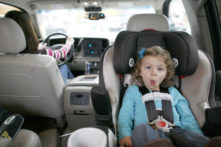Published: SRN July/August, 2017. Updates will be posted here as they become available.
Update: August 31, 2018. The American Academy of Pediatrics (AAP) has revised their policy on child passenger safety.
Update December 2017: “Updated Study on RF vs. FF Effectiveness.”
Update mid-November 2017: “Car Sear Orientation and Safety.”
Update September 2017: “NHTSA Policy Reaffirmation.”
Over the past year, certain developments have caused some CPS advocates to be concerned and/or confused about the relative safety of children riding rear facing versus forward facing. Testimony in a recent lawsuit that questioned the benefits of extended RF, changes to RF and FF requirements in CR instructions, and updated state laws have all contributed to the confusion. Most recently, an expression of concern published by Injury Prevention and an online statement posted by the CR manufacturer Dorel have understandably raised many questions among CPSTs. The following describes these developments and gives additional context to help CPSTs make sense of recent news.



